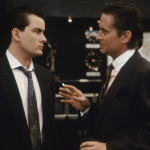Who’s That Knocking at My Door Review
Martin Scorsese’s directorial career kicked off with 1967’s Who’s That Knocking at My Door, a stylistically ambitious but dramatically flat slice of New York Italian realism. Show this movie to someone unfamiliar with the director’s masterpieces, and he or she would likely point out the tremendous potential that drips from almost every frame. But Who’s That Knocking at My Door is an incredibly hard film to get behind. For one, it’s 90 minutes long but feels twice that. Nothing of great consequence happens, and the drastic differences between the subtlety of the story and the bombast of Scorsese’s direction makes for a pretty jarring viewing experience.
J.R. (Harvey Keitel in his big-screen debut) is a low-level gangster in the Big Apple. He spends his days just fucking around, drinking, playing some cards, and plotting some truly small-potatoes crimes with his best pals including Joey (Lennard Kuras) and the always-picked-on Sally Gaga (Michael Scala). One day, J.R. begins chatting with a girl (Zina Bethune) about magazines and films. It’s very casual, but she’s very pretty, and he’s pretty funny, so they meet again to check out a movie. And before long, they’re an official item.
J.R., however, is careful to keep his relationship with this girl and his “career,” i.e. his time with his friends, separate. He’s observed the way these guys treat women, and he cherishes his girl too much to subject her to that. There’s also an element of embarrassment present; J.R. knows he isn’t worthy of this girl, and if she sees what he does everyday, she might wake up and realize it. Everything changes, however, near the film’s halfway mark, when J.R.’s girl shares a dark secret with him that threatens their relationship and throws his perfect balance out of whack.
Who’s That Knocking at My Door begins with a bang—a lengthy, very naturalistic “meet cute” between J.R. and the girl during which they dissect The Searchers and discuss the rising costs of pop culture magazines. Set to some of New York’s most unpleasant sounds (honking cars, passing trains, footsteps, and crying babies), the scene is both adorable and a little unsettling. It’s love (or at least attraction) in the purest sense, but what’s going on around them is drab, obnoxious, and ugly.
Unfortunately, those three adjectives could also describe the remainder of the film. The most egregious moment occurs near the halfway mark when we observe J.R. dreaming about having lots of sex with different women. It’s totally superfluous and was apparently only included because the film’s distributor demanded more sex in the film. You can look at the film’s editing (courtesy of Thelma Schoonmaker, who, like Scorsese, is working on her first film), which is off-putting in its quickness and repetition, as another sign of this film’s style drowning out its substance.
It doesn’t help that the story and, to a lesser extent, its characters are quite dreary. You like them, but as the film slowly limps to its conclusion, you’ll just stop caring. The easiest way to sum up this film is to say it’s quite obviously an auteur’s first feature. Good on Scorsese for doing what he wanted to do in an unusual way. One gets the sense that if he can hammer out this film’s storytelling kinks, he might have good things in his future.
















